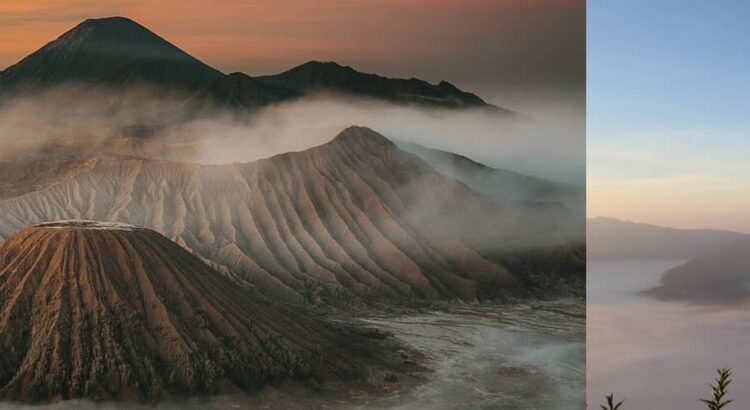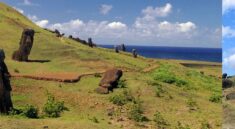Nestled in the captivating landscapes of East Java, Indonesia, the Taman Nasional Bromo Tengger Semeru, or Bromo Tengger Semeru National Park, stands as a testament to the country’s natural wonders. This vast national park, covering an expanse of over 800 square kilometers, is a mesmerizing tapestry of volcanic peaks, dense forests, and cultural richness. Its name pays homage to the three prominent mountains within its borders: Mount Bromo, Mount Tengger, and Mount Semeru, each contributing to the park’s unique allure.
The iconic silhouette of Mount Bromo, an active volcano, is perhaps the most recognized feature of the national park. Rising to an altitude of 2,329 meters (7,641 feet), Bromo exudes an otherworldly charm. Visitors often embark on a pre-dawn journey to witness the sunrise from vantage points like Penanjakan, where the first light of day unveils a surreal panorama. As dawn breaks, the ethereal beauty of Mount Bromo, surrounded by a sea of volcanic sand, captivates all who behold it.
Mount Tengger, with its caldera encompassing the Sea of Sand and the whispering winds, adds to the park’s mystique. The Tenggerese people, an indigenous community residing in the highlands, hold the crater edges sacred and celebrate the annual Yadnya Kasada festival, where offerings are thrown into the crater as a gesture of gratitude to the mountain gods.
Dominating the eastern horizon, Mount Semeru, the highest peak in Java at 3,676 meters (12,060 feet), is a challenging ascent for trekkers and mountaineers. The journey to Semeru’s summit promises breathtaking views and a profound sense of accomplishment.
The vast Sea of Sand, a surreal expanse surrounding Mount Bromo, is a unique geological feature. Its ashen plains and whispering winds create an almost lunar atmosphere, setting the stage for a distinctive adventure.
How to get there
Getting to Taman Nasional Bromo Tengger Semeru in East Java, Indonesia, involves a combination of land and air travel. The primary gateway to the national park is through the town of Probolinggo. Here’s a general guide on how to get to Bromo Tengger Semeru National Park:
By Air:
- Arrive in Surabaya:
- Most visitors fly into Juanda International Airport in Surabaya, the capital of East Java. Surabaya is well-connected to major cities in Indonesia.
- Travel to Probolinggo:
- From Surabaya, you can take a train, bus, or private transport to Probolinggo. The journey takes approximately 2 to 3 hours by train or bus, depending on traffic and road conditions.
By Train:
- Take a Train to Probolinggo:
- Board a train from Surabaya’s Gubeng Station or Pasar Turi Station to Probolinggo. Trains run regularly, and the journey provides scenic views of the East Java landscape.
- Arrive in Probolinggo:
- Disembark at Probolinggo Railway Station. From there, you can hire a local transport service, such as a shared minivan or private car, to continue your journey to Cemoro Lawang, the main access point for Mount Bromo.
By Bus:
- Take a Bus to Probolinggo:
- Long-distance buses also operate from Surabaya to Probolinggo. The journey time varies depending on traffic conditions.
- Arrive in Probolinggo:
- Alight at Probolinggo Bus Station. From here, you can find local transport options to Cemoro Lawang.
From Probolinggo to Cemoro Lawang:
- Local Transport:
- Hire a local transport service, such as an angkot (shared minivan) or an ojek (motorcycle taxi), to reach Cemoro Lawang. Negotiate the fare before starting the journey.
- Private Car Rental:
- Consider renting a private car with a driver for a more comfortable and flexible journey. This option allows you to explore the surrounding areas at your own pace.
- Journey to Bromo Tengger Semeru:
- Cemoro Lawang serves as the starting point for exploring Bromo Tengger Semeru National Park. From here, you can arrange guided tours or hikes to Mount Bromo, Mount Tengger, and Mount Semeru.
Things to do
Bromo Tengger Semeru National Park offers a diverse range of activities, catering to nature enthusiasts, adventure seekers, and those interested in cultural experiences. Here are some things to do when visiting this captivating Indonesian national park:
- Sunrise at Mount Bromo:
- Wake up early and experience the magical sunrise over Mount Bromo. Head to viewpoints like Penanjakan to witness the sun casting a golden glow on the surrounding volcanic landscape.
- Mount Bromo Summit Hike:
- Embark on a hike to the summit of Mount Bromo. The trek takes you through the Sea of Sand, and you can climb the stairs to the crater rim for a closer look into the active volcano.
- Trekking Mount Semeru:
- For avid trekkers, consider conquering the challenging ascent to the summit of Mount Semeru, the highest peak in Java. The journey offers breathtaking views and a sense of accomplishment.
- Whispering Sands (Pasir Berbisik):
- Explore the Whispering Sands, a unique expanse of volcanic sand near Mount Bromo. The area is known for its fine black sand, and the winds create a whispering sound as they pass through the dunes.
- Cemoro Lawang Village:
- Visit the charming village of Cemoro Lawang, the gateway to Bromo Tengger Semeru National Park. Experience the local culture, interact with the Tenggerese people, and explore the traditional architecture.
- Yadnya Kasada Festival:
- If your visit coincides with the annual Yadnya Kasada festival, observe the Tenggerese people’s unique ritual of offering agricultural produce and livestock at the crater of Mount Bromo.
- Bromo Crater Photography:
- Capture the mesmerizing landscapes of the Bromo Tengger Semeru region. The diverse terrain, including volcanic craters, mountain ranges, and the Sea of Sand, provides ample opportunities for photography.
- Savana and Teletubbies Hills:
- Explore the lush savanna and rolling hills, often referred to as Teletubbies Hills, near Mount Bromo. The green expanses contrast with the volcanic landscapes, creating a picturesque setting.
- Madakaripura Waterfall:
- Venture to Madakaripura Waterfall, the tallest waterfall in Java, located in the park’s vicinity. The journey involves a scenic trek through a canyon, and the waterfall is a refreshing sight.
- Trekking to Ranu Kumbolo:
- For nature lovers, embark on a trek to Ranu Kumbolo, a serene alpine lake surrounded by lush landscapes. The trek offers a tranquil escape and stunning views of the surrounding peaks.
- Caving at Widodaren Cave:
- Explore the mystical Widodaren Cave, known for its unique rock formations and cultural significance. The cave is a hidden gem for those interested in spelunking.
- Star Gazing:
- Stay overnight and experience the clear night skies. Bromo Tengger Semeru National Park, with its minimal light pollution, provides an excellent opportunity for star gazing.
When visiting Bromo Tengger Semeru National Park, it’s recommended to check weather conditions, wear suitable attire for outdoor activities, and consider guided tours for a more enriching experience. Whether you seek adventure, cultural immersion, or simply the beauty of nature, this national park offers a multitude of experiences to satisfy every traveler.
Things not to forget
When visiting Taman Nasional Bromo Tengger Semeru in Indonesia, it’s important to come prepared for an unforgettable adventure amidst stunning natural landscapes and cultural richness. Here’s a list of essential items not to forget:
- Entry Permits:
- Make sure to obtain the necessary entry permits or passes required for visiting the national park. These permits can typically be purchased at the park entrance or online in advance.
- Comfortable Clothing:
- Dress in comfortable and breathable clothing suitable for outdoor activities and varying weather conditions. Light layers are recommended, as temperatures can fluctuate throughout the day.
- Sturdy Footwear:
- Wear sturdy and supportive footwear, such as hiking boots or trekking shoes, especially if you plan to explore the park’s trails and rugged terrain.
- Sun Protection:
- Bring sunscreen, sunglasses, and a wide-brimmed hat to protect yourself from the strong sun at high altitudes. The UV rays can be intense, even on cloudy days.
- Water and Snacks:
- Carry an ample supply of drinking water to stay hydrated during your explorations. Pack nutritious snacks such as energy bars, nuts, or fruits to keep your energy levels up throughout the day.
- Camera and Binoculars:
- Capture the breathtaking scenery and wildlife encounters with a camera or smartphone. Binoculars can also enhance your wildlife viewing experience, allowing you to spot birds and other wildlife from a distance.
- Navigation Tools:
- Bring a map, compass, or GPS device to help navigate the park’s trails and landmarks. Cell phone reception may be limited in remote areas, so having offline maps can be invaluable.
- First Aid Kit:
- Pack a basic first aid kit containing essentials such as adhesive bandages, antiseptic wipes, pain relievers, and any personal medications you may require.
- Cash and Small Change:
- Carry sufficient cash in the local currency for park entrance fees, transportation, and purchases from local vendors. Small denominations are useful for tipping guides and vendors.
- Respectful Attire:
- When visiting cultural sites or interacting with local communities, dress modestly and respectfully. This may include covering shoulders, legs, and removing footwear when entering sacred sites.
- Responsible Waste Management:
- Help minimize your environmental impact by bringing reusable water bottles and avoiding single-use plastics. Pack out any trash and dispose of it responsibly in designated bins.
- Emergency Contacts:
- Keep a list of emergency contacts, including local authorities, park rangers, and embassy or consulate information, in case of unforeseen circumstances or emergencies.
By remembering these essential items, you’ll be well-prepared to embark on an enriching and enjoyable journey through Taman Nasional Bromo Tengger Semeru, fully immersing yourself in its natural wonders and cultural heritage.
Best time to visit
The best time to visit Taman Nasional Bromo Tengger Semeru in Indonesia is during the dry season, which typically occurs from April to November. Here’s why:
- Clear Skies and Visibility:
- The dry season is characterized by clear skies and lower chances of rainfall. This provides excellent visibility of the stunning landscapes, especially during sunrise and sunset. The iconic views of Mount Bromo and the surrounding volcanic peaks are at their best during this time.
- Ideal for Outdoor Activities:
- The dry season offers favorable conditions for outdoor activities such as trekking, hiking, and exploring the national park’s trails. The trails are less muddy, making it easier to navigate the rugged terrain.
- Enhanced Sunrise and Sunset Views:
- One of the highlights of visiting Bromo Tengger Semeru is witnessing the sunrise over the volcanic landscape. Clear skies during the dry season enhance the beauty of this magical moment. Similarly, sunsets are also captivating during this time.
- Cultural Festivals:
- The Yadnya Kasada festival, celebrated by the Tenggerese people, is an annual event that usually takes place around the 14th day of the Kasada month in the traditional Javanese calendar. If your visit coincides with this festival, you can witness unique ceremonies and cultural activities.
- Wildlife and Flora:
- The dry season allows for better wildlife spotting and exploration of the park’s diverse flora. The lush landscapes provide a vibrant backdrop, and you may encounter various bird species and other wildlife.
While the dry season is generally recommended for optimal conditions, it’s essential to keep in mind that Bromo Tengger Semeru National Park can still be visited during the wet season (December to March). The wet season brings lush greenery and unique perspectives, but trekking conditions may be more challenging due to muddy trails. Consider your preferences for activities and weather when planning your visit to this breathtaking Indonesian destination.
Is Mount Semeru still active?
Yes, Mount Semeru, located in Taman Nasional Bromo Tengger Semeru (Bromo Tengger Semeru National Park) in East Java, Indonesia, is an active volcano. It is the highest mountain on the island of Java, standing at an elevation of 3,676 meters (12,060 feet) above sea level. Semeru is known for its frequent activity, including the release of ash clouds and occasional eruptions.
The activity of Mount Semeru is closely monitored by local authorities, and periodic alerts or restrictions may be issued based on the volcano’s activity levels. It’s important for visitors and trekkers to check the current status of Mount Semeru before planning any trips to ensure safety.
Despite its active nature, Mount Semeru is a popular trekking destination, attracting adventurers and nature enthusiasts who seek to witness its unique beauty and experience the challenging ascent to the summit. Visitors are advised to follow safety guidelines, adhere to park regulations, and stay informed about any updates regarding volcanic activity in the region.
What is the highest volcano in Java?
The highest volcano in Java is Mount Semeru. Mount Semeru, also known as Mahameru (Great Mountain), stands as the highest peak on the island of Java, Indonesia. It is an active volcano located within Taman Nasional Bromo Tengger Semeru (Bromo Tengger Semeru National Park). Mount Semeru is renowned for its frequent eruptions and is a popular destination for trekkers and mountaineers seeking both adventure and panoramic views from its summit.
With an elevation of 3,676 meters (12,060 feet) above sea level, Mount Semeru not only holds the title of the highest volcano in Java but also ranks as the highest peak on the entire island. The challenging trek to the summit offers breathtaking landscapes, including volcanic craters, lush forests, and the surrounding beauty of Taman Nasional Bromo Tengger Semeru.
What type of volcano is the Semeru volcano?
Mount Semeru is a stratovolcano, also known as a composite volcano. Stratovolcanoes are characterized by their steep-sided profile and a symmetrical cone-shaped structure. These volcanoes are typically composed of alternating layers of lava flows, volcanic ash, and other volcanic rocks. The eruptions of stratovolcanoes can be explosive and are often associated with the release of ash, pyroclastic flows, and lava.
Semeru’s status as a stratovolcano is reflected in its geological structure and eruptive behavior. It is known for its regular eruptions, with historical records documenting a consistent pattern of activity. The volcano has a well-defined summit crater called Jonggring Saloko, which is often the source of eruptions.
As one of the most active volcanoes in Indonesia, Mount Semeru poses both geological and natural beauty, attracting trekkers and adventurers seeking to witness its eruptions and experience the challenging ascent to its summit.
What are some fun facts about Mount Semeru?
- Highest Peak in Java:
- Mount Semeru holds the distinction of being the highest peak on the island of Java, Indonesia, with an elevation of 3,676 meters (12,060 feet) above sea level.
- Active Volcano:
- Semeru is an active stratovolcano and is known for its frequent eruptions. The volcano exhibits a dynamic and ever-changing landscape, with ash clouds, pyroclastic flows, and occasional lava flows.
- Sacred to the Tenggerese People:
- Mount Semeru is considered sacred by the Tenggerese people, who reside in the highlands near the volcano. They believe that the mountain is the abode of the ancestral spirits and hold annual ceremonies and festivals, such as the Yadnya Kasada, to offer prayers and offerings.
- Yadnya Kasada Festival:
- The Yadnya Kasada festival is a unique cultural event celebrated by the Tenggerese people. It involves a ritual of throwing offerings, including fruits, vegetables, and livestock, into the crater of Mount Bromo as a gesture of gratitude to the mountain gods.
- Challenging Trekking Destination:
- Mount Semeru is a popular trekking destination, attracting adventure enthusiasts from around the world. The trek to the summit is challenging but rewarding, offering breathtaking views of volcanic landscapes and surrounding mountains.
- Summit Crater – Jonggring Saloko:
- The summit of Mount Semeru is marked by a crater called Jonggring Saloko. This crater is the source of the volcano’s eruptions and is characterized by its ever-changing nature due to volcanic activity.
- Part of Bromo Tengger Semeru National Park:
- Mount Semeru is part of the Bromo Tengger Semeru National Park, which encompasses a diverse range of landscapes, including other volcanic peaks like Mount Bromo and Mount Tengger. The national park is a UNESCO World Heritage Site.
- Fertile Surroundings:
- The volcanic soils around Mount Semeru are highly fertile, supporting agriculture in the region. Local communities engage in farming activities, cultivating crops such as vegetables and fruits in the nutrient-rich volcanic soil.
- Regular Eruptions:
- Semeru is known for its regular eruptions, with periods of increased activity leading to the release of ash clouds and volcanic material. Despite its activity, it continues to be a fascinating destination for those intrigued by the forces of nature.
- Breathtaking Views:
- Trekkers who make the journey to the summit are rewarded with breathtaking views of the surrounding landscapes, including the Sea of Sand and the neighboring peaks of Bromo and Tengger.
Mount Semeru’s combination of geological significance, cultural importance, and stunning natural beauty makes it a captivating and iconic feature in the Indonesian landscape.
Image credits: upload.wikimedia.org





